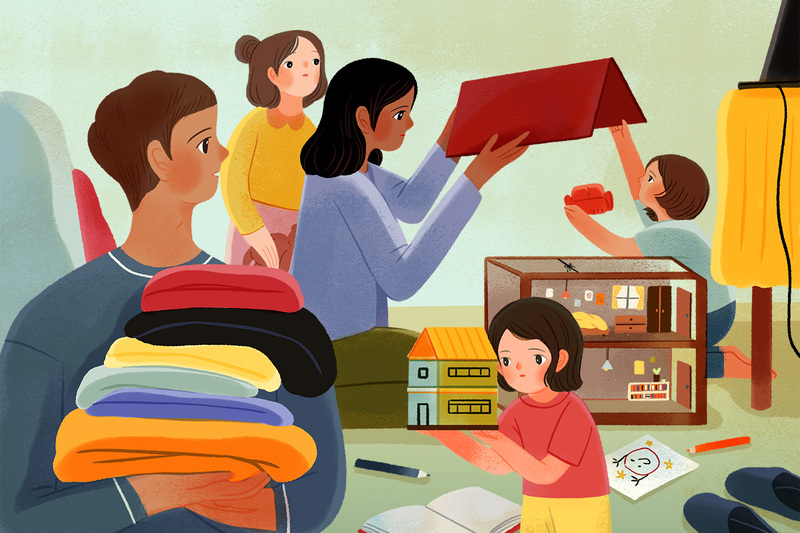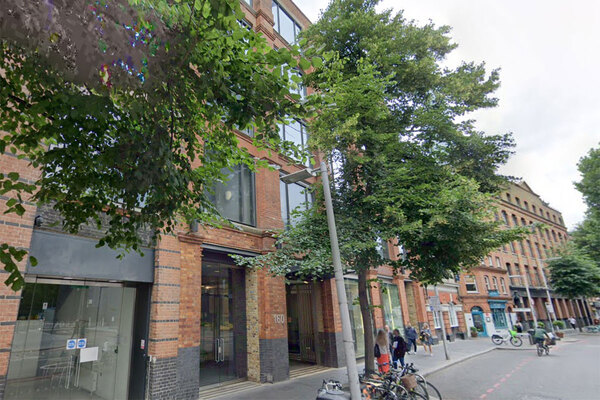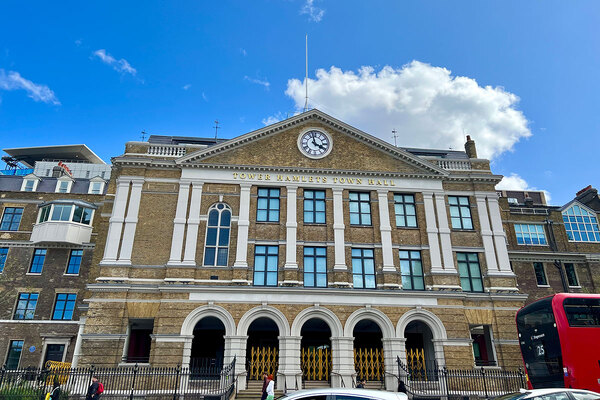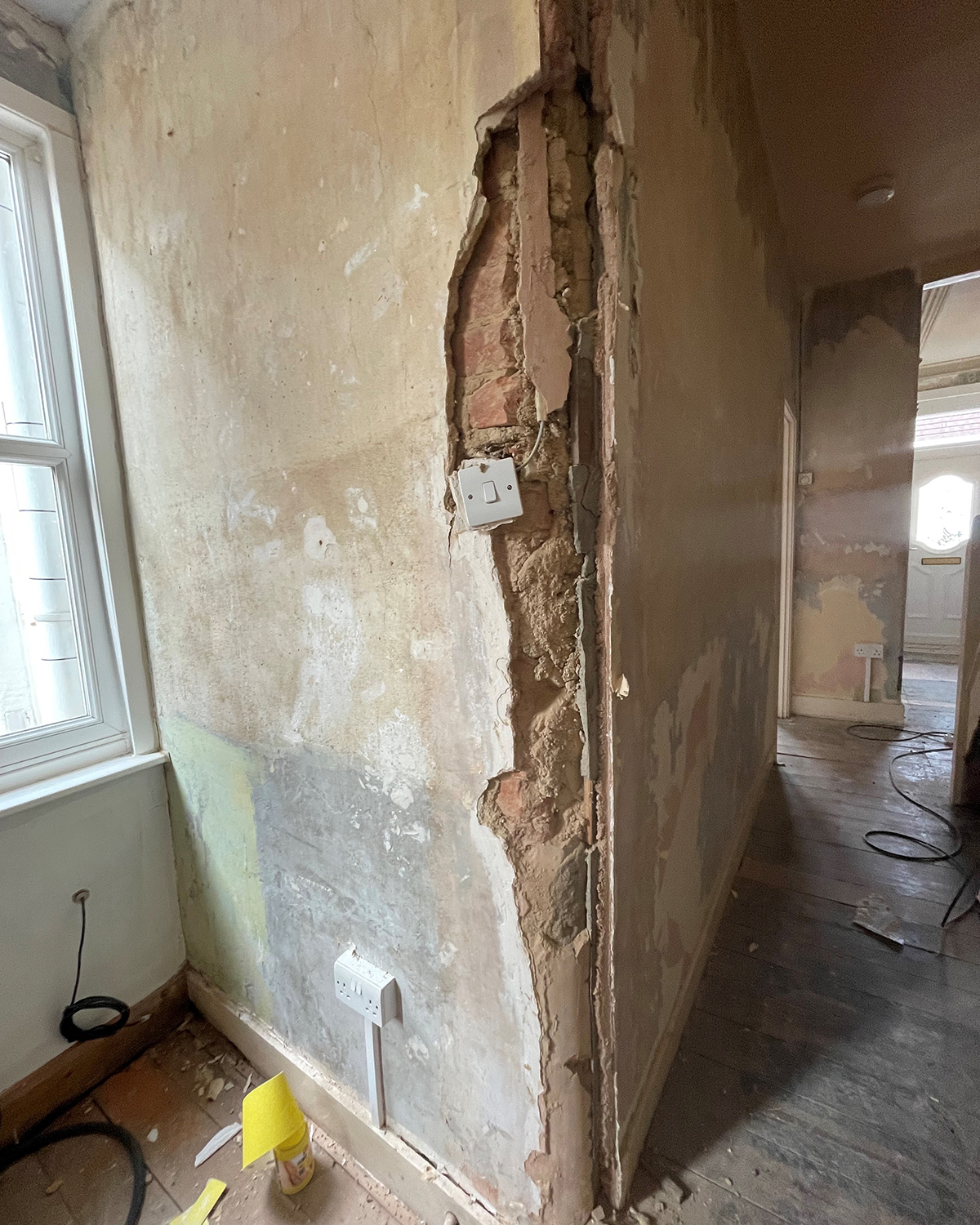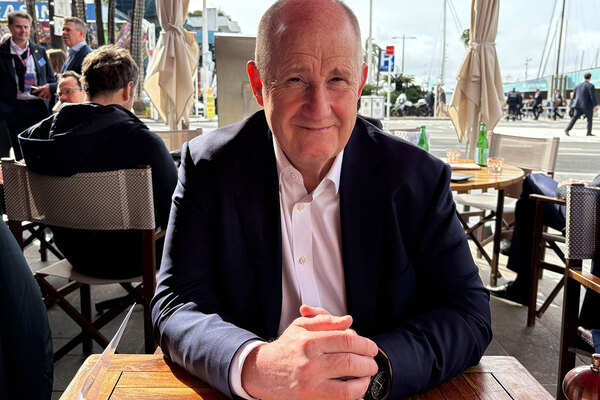Overcrowded and on the waiting list: the family housing crisis and what can be done to solve it
Within the housing shortage, one group is particularly affected: families in need of a larger home. But how big is the demand? And how can building policy and allocations change, to ease the problem? Jess McCabe investigates. Illustration by Hao Hao
I was editing a comment piece for Inside Housing and spotted what I thought was an error. Victor da Cunha, chief executive of housing association Curo, had written that in Bath, a family needing to be rehoused into a four-bedroom home would need to wait for 100 years.
The figure was so large, I assumed that someone had added a zero by mistake. But it wasn’t a mistake.
Talking on the phone later, Mr da Cunha told Inside Housing: “I went to check the figures [before this call], and about 10% of everyone in the waiting list needs something more than four bedrooms.”
We are used to talking about the large volume of homes the country needs – the new Labour government is aiming for 1.5 million in five years. But within those broad numbers is hiding a more specific crisis – there are just not enough affordable homes suitable for families, and even fewer for large families.
Family homes crisis
Inside Housing has heard snippets about this crisis over the past few years from people working in the sector – some of whom are themselves struggling to find an affordable family home (see box). We wanted to investigate further. How big is this crisis? What is driving the specific shortage of family homes? And what can be done about it?
There are 1.29 million households on the waiting list for housing in England, according to the latest government statistics. But how many need larger, family homes?
A planning study by Tower Hamlets council in London in 2020 found that 37% of the people on its waiting list were living in overcrowded conditions. Overall, 42% of households with children in the borough did not live in family homes (three bedrooms or more).
Aberdeenshire Council’s strategic plan for the next five years gives a window into how another area of the UK is coping. There were only eight four-bedroom home vacancies in one year (the council analysed 2022-23 for this exercise), each receiving some of the highest number of bids.
The problem in Bath, Mr da Cunha says, dates back to the Right to Buy, when larger, family homes with nice views were the most popular and most likely to be sold. And the families living in larger homes that weren’t sold are not moving. “They’re the ones people want to stay in for life – in larger family homes, people have an emotional connection with them,” he adds.
The consequences of this for families stuck in overcrowded or inappropriate housing are huge. Some will be experiencing psychological difficulties of coping in a space that is too small. Some will be living in temporary accommodation while they wait for homes.
Richard Cook, chief development officer at Clarion, sums it up: “The outcome of overcrowding is all these issues, around damp and mould, ventilation – and ultimately, mental health and living problems and challenges.”
So are landlords meeting this demand by building more family homes? Aberdeenshire’s data shows that only 17 four-bedroom affordable homes and three five-beds were completed that year in the area, by all social landlords.
Ten housing associations that completed the most three-bedroom-plus homes
Housing association | 3-bed homes completed 2023-24 | 4-plus-bed homes completed 2023-24 | Percentage of development that is family housing | 3-bed homes started on site in 2023-24 | 4-plus-bed starts |
Sanctuary | 785 | 65 | 83.3% | 330 | 16 |
Places for People | 502 | 154 | 37.5% | 829 | 201 |
Sovereign Network Group | 559 | 76 | 31.5% | 161 | 36 |
L&Q | 486 | 137 | 21.1% | 86 | 31 |
Riverside | 497 | 107 | 41.5% | 235 | 108 |
Platform Housing Group | 514 | 64 | 48.1% | 744 | 130 |
Stonewater | 484 | 83 | 47.0% | 349 | 68 |
Vivid1 | 413 | 82 | 32.5% | 603 | 112 |
Torus | 383 | 78 | 52.7% | 511 | 130 |
Clarion | 288 | 172 | 29.9% | 450 | 65 |
Source: Inside Housing
Note: 1. Only includes figures for affordable homes, not total completions
This year, we added new questions to our annual survey of development by housing associations (the Biggest Builders), in order to gather a wider picture. We wanted to find out how many of the homes being built by the largest associations were of three, four or more bedrooms. Our wider dataset of 162 associations built just under 50,000 homes. Of these, 29% had three bedrooms. But only 5.7% – or 2,847 homes – had four bedrooms or more.
L&Q completed 623 homes of three bedrooms and above. The lack of larger homes is something Vicky Savage, group director of development and sales, is acutely conscious of.
“In London, this has been the case for decades that we just were not building enough larger family homes,” she says. “It’s not only the problem with overcrowding of our own stock, but it’s all of those people that are sitting on housing waiting lists that will sit on those lists forever because the supply is not coming through.”
“When we are doing a land-led scheme, so when we are totally in control of it all, we will look to see how many three-bedrooms we can do,” she says.
Hayley’s fight for a four-bedroom home
Plaster was falling off the wall of the four-bedroom home pictured above, when Hayley* and her four children moved in last August. A light switch hung on, barely attached. The stairs had come away from the wall.
The family couldn’t safely move in at first. “I was paying rent on two homes,” says Hayley, who works for a housing association.
But more than a year later, the stairs have been fixed (by her social landlord) and the walls have been replastered (at her own expense). And, most importantly, her family has a stable and secure home.
The process has taken more than four years. Hayley was living in a private rented home when she first approached her council for help in 2019, because she had split up with her partner, who was abusive.
“There were difficulties around him refusing to leave, and when he did eventually leave, there were instances where he broke into the home,” she says. “We just needed to be out of that address.”
Her children are now 15, 13, 11 and eight. At the time Hayley initially approached the council, her youngest was only three-and-a-half.
Getting support from the council was difficult. Hayley was offered, and accepted, a rent deposit to help find somewhere else to privately rent. But she could only afford a three-bedroom house, which left three of her children having to share a room.
Then, her ex found out the new address. Hayley approached the council again, and was again fobbed off. At this point, Hayley got the help of an advocate from a homelessness charity who took over interacting with the council on her behalf. They took her case to the Local Government and Social Care Ombudsman, which found “fault leading to personal injustice” and awarded £3,125.
The family was placed on the waiting list, and their place was backdated to where they should have been if they had been added in 2019. It was shortly after this that Hayley was able to secure her current four-bedroom house from a housing association (not the one that employs her).
Despite the state of the home when they moved in, Hayley says: “It’s the best that I have ever felt. Knowing it’s a home we can stay in forever, for a family who have had…” she pauses to gather her words. “It has been a chaotic start to [the children’s] lives. Having that security is the most important part of it.”
*Hayley asked to be referred to by her first name
A number of development directors told Inside Housing that land-led developments, rather than Section 106 sales, are key to building more in line with housing need. Mr Cook from Clarion explains that the association has set a limit where it won’t purchase or develop a project with more than 20% one-bedroom homes on the site.
When asked about how to build more large family homes, housing associations in England want to talk about their broader asks for government, such as a rent settlement. This could bolster development overall, but is more needed to ensure family homes are built?
Council plan
Some councils are trying to address the issue at planning level: Tower Hamlets’ current local plan says 30% of new affordable rent homes must have three bedrooms and 15% must have four bedrooms. It is in the draft stages of a new plan, which would increase the numbers to 40% three bedrooms and 25% four bedrooms.
Gerraint Oakley, executive director of growth and development at 48,000-home Platform, suggests that one fix could be to provide more grant for larger homes – similar to how projects can attract more grant if they use modern methods of construction.
5.7%
Homes built by housing associations that had four or more bedrooms in 2023-24
100
Years wait for a four-bedroom house in Bath
201
Four-plus-bed home starts by Places for People in 2023-24
Homes England and the Greater London Authority calculate grant on the basic number of homes, and don’t differentiate between the funding for a one-bedroom flat and a five-bedroom home. This means that larger homes are harder to build. “It’s just the nature of it – it takes a bigger piece of your land,” he says.
This is something Mr Cook from Clarion would also support. He notes that as larger homes have higher rents, over 30 years of a business plan, the viability gap isn’t that big. But: “If the grant was weighted even slightly… I think that would drive more family homes.”
Downsizing could play a critical role in easing the pressure on larger homes. But the current allocations system in England is not set up to encourage this. To take the example of grandparents living in a four-bedroom home after their children have moved out, current allocation rules mean they would only be able to downsize to a one-bedroom home. Even if you remove the factor of the emotional attachment to the family home, it is not hard to see why this might not be appealing, if they want to be able to have children or grandchildren over to stay, for example.
The rules are designed to prevent people moving into a home that they would be ‘under-occupying’. But a rule change that allows households to downsize a bit, but have a spare room, might free up some of the most-needed larger homes in the country.
“What happens is, you allocate a one-bed to somebody. And before you know, it’s 10 years on, they are a family of three or four, but there’s nowhere for them to go. There’s not enough larger stock available,” Mr Cook points out.
High-density family living
“In London, most of what we build is apartments,” says Vicky Savage, development director at L&Q. “We are building some houses in Greenwich and three and four-bed townhouses. And it’s happy days, because
I can’t remember the last time we built houses.”
We were talking on Teams about the design side of how L&Q is trying to build family housing.
“You ask any family what they want. They want the front and back garden. That is not possible in cities, and so we need to make sure that we can give an offering that is as good as it can be for families living in high rises.”
Inside the home, space standards are very important.
“There could be six people living in that [three-bedroom home] so it’s double the occupancy of what a private home would be.” But outside, the “public realm” is also crucial.
On some schemes, L&Q has put the larger homes on the ground floor, so families can have gardens. On other schemes, it has added larger balconies.
Ms Savage also mentions that location is really important: parks and other facilities that appeal to a broader age group. “Whereas a toddler might like a little wild meadow with some wooded stuff, a teenager needs maybe a ball court. We’ve got one [scheme] in Bexley. It joins a park, which is really great, especially [for] the older children, if you’re placing those three-beds in the right neighbourhoods. You don’t have to provide everything on site, because the kids have got a two-minute walk to a really good play area next door.”
David Jaques is the assistant director for housing development at Cardiff Council, which in Wales has the role of distributing grant to housing associations, as well as running its own development programme. “When we looked across our programmes where we support housing associations with grant and so on, it was a lot of one and two-bed flats, two and potentially three-bed houses, and not a lot of three, four, five-bed homes. And we got a lot of families that need a larger home,” he says.
Cardiff has taken a number of routes to address this: building more larger homes in its own programme and buying back homes that were sold under the Right to Buy. But it is also building homes specifically to target people under-occupying their social home, and encouraging them to downsize.
Mr Jaques gives the example of one recent Cardiff Council development – out of 41 homes, almost all went to downsizers. This freed up larger homes for others on the waiting list.
It is also in planning for its James Street, Butetown project, which aims to build multi-generational housing on a derelict site. If it gets the green light, it will be the first of its kind for the council.
Lynda Thorne, cabinet member for housing and communities, explains: “We’ve got three-storey town houses and we’ve got smaller apartments, but some of them can be opened up and joined together without any major building works.”
So there are options available to build more family homes, and to encourage downsizing. The question is: will they be taken up?
Recent longform articles by Jess McCabe
Inside Housing Repairs Tracker 2024
How much did English housing providers spend on repairs and maintenance in 2022-23? Jess McCabe looks through their financial records to find out
Who has built the most social rent in the past 10 years?
Jess McCabe delves into the archives of our Biggest Builders data to find out which housing associations have built the most social rent homes
Biggest Council House Builders 2024
For the second year running, Inside Housing names the 50 councils in Britain building the most homes. But is the rug about to be pulled on council development plans? Jess McCabe reports
Inside Housing Chief Executive Salary Survey 2024
Inside Housing’s annual survey reveals the salaries and other pay of the chief executives of more than 160 of the biggest housing associations in the UK, along with the current gender pay gap at the top of the sector. Jess McCabe reports
Sign up for our asset management newsletter
Already have an account? Click here to manage your newsletters
